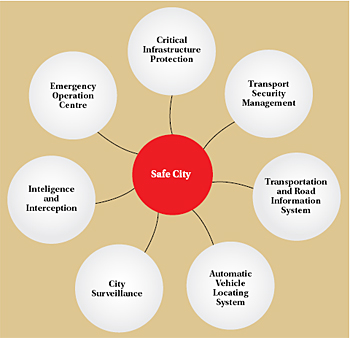INDIAN ARMED FORCES CHIEFS ON
OUR RELENTLESS AND FOCUSED PUBLISHING EFFORTS

SP Guide Publications puts forth a well compiled articulation of issues, pursuits and accomplishments of the Indian Army, over the years

I am confident that SP Guide Publications would continue to inform, inspire and influence.

My compliments to SP Guide Publications for informative and credible reportage on contemporary aerospace issues over the past six decades.
- Prime Minister witnesses 'Bharat Shakti' – a Tri-Services Firing and Manoeuvre Exercise in Pokhran, Rajasthan
- Interim Defence Budget 2024-25 — An Analysis
- Union Defence budget 2024
- Prime Minister Modi Commemorates Indian Navy Day in a Grand Ceremony
- Prime Minister Modi Flies in the LCA Tejas
- New Chapter in India-Italy Defence Ties
- Airpower beyond Boundaries
Securing cities

Two news reports related to safe cities emerged in media in recent weeks. First related to paucity of funds with the Kolhapur Municipal Corporation (KMC) to implement its Safe City project in a phased manner since the overall project costs reportedly amounts to around Rs. 11 crore in addition to an annual expenditure to keep it operational. The project involves installing around 250 CCTV cameras across 67 key points in the city and other systems like for command and control, emergency vehicle tracking, public address, traffic challan and visitor information management.
The second media report related to visit of a delegation from the Government of Uganda to the Gujarat Government’s eGujCop project, connecting all police stations with high bandwidth network and digitising the entire police paperwork, the meeting taking place on the sidelines of the 18th National Conference on e-Governance held at Gandhinagar on January 30 and 31. Public safety is a vital duty and function for the government which implies ensuring the safety of its citizens, organisations and institutions against threats to their well-being as well as the traditional functions of law and order. In simple terms Safe Cities comprise: one, critical infrastructure protection; two, transport security management; three, transportation and road information system; four, automatic vehicle locating system; five, city surveillance; six, intelligence and interception system, and; seven, emergency operation centre.
The UN-Habitat Safer Cities Programme aims to reinforce personal safety and reduce fear by improving safety services and accountability to the community through following: first, building urban safety through urban vulnerabilities reduction – with special attention to violence and crime; second, building urban safety through urban planning, management and governance – sustainable urbanisation by emphasising inclusive and participatory urban planning, local development practices, incorporates policy-making and strategy development to promote institutional and organisational development, resource planning and management to boost efficiency in governance, and; third, improving the governance of safety – where there is fearless interaction among people and groups, creating an enabling environment for the inhabitants of the city, allowing improved quality of life and fostering economic development.
The Constitution of India enjoins the Union to protect every state against external hostility and internal disorder in order to ensure that the governance of every state is carried out in accordance with the provisions of the Constitution. As per the Seventh Schedule to the Constitution, ‘Police’ and ‘Public Order’ are State subjects and, therefore, the State Governments are primarily responsible for the prevention, registration, detection and investigation of crime and prosecution of the perpetrators of crime within their jurisdiction. However, the Central Government supplements the efforts of the States through funds for modernisation, training and infrastructure of the state police forces; CCTVs, radio tetra sets, forensic laboratories, weaponry, vehicles, computerisation and training infrastructure, etc.
The megacity policing plan introduced in 2005 has been progressing. $72 million has been allocated under this scheme for period 2013-17. Policies and physical measures are must to ensure that a nation’s critical infrastructure possesses readiness and ability to recover from attacks, accidents or natural disasters. In terms of critical infrastructure protection, Frost & Sullivan Global PSIM Market, 2013 forecasts total C4ISR spending between 2012 and 2021 to be $1,113 billion and the value of physical security information management market to reach $2,789 million by 2021. With such enormous costs, capacity building for safe cities must perforce be systematic and graduated. Building capacities of departmental officials involved in operations and decision making too is must for developing requisite knowledge, skills, attitude and culture. Collaborative monitoring should be ensured through integrating surveillance, communication and data gathered by government and private establishments. Network connectivity is one of the most important components of a safe city project and needs careful attention in assessment, planning and implementation.
It is the backbone of the system in which data travels from the surveillance systems to the data centres and control viewing centres. It is in such context that Prime Minister Narendra Modi had called for Smart Cities and launched the Digital India plan. The states should capitalise on these initiatives in taking India to the next level. Fundamentally, the Safe Cities plan should be standard, simple, open and on open scalable architecture demand, meeting requirements of flexibility, intelligence, reliability and high quality.





